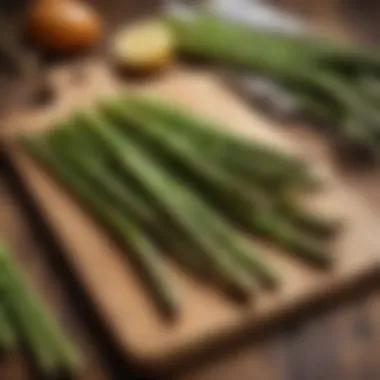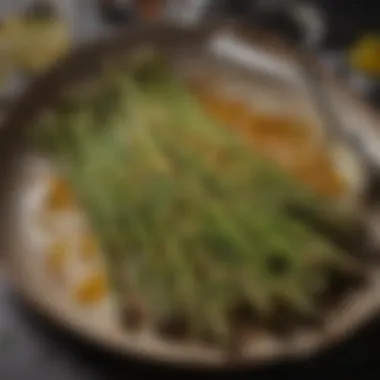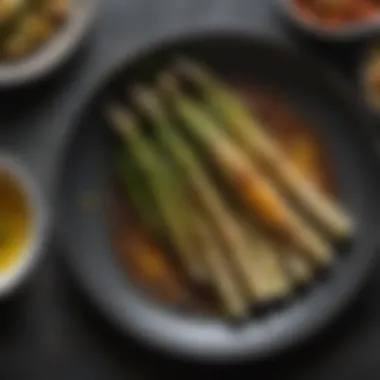The Ultimate Guide to Baking Asparagus Perfectly


Intro
Baking asparagus is a culinary technique that combines simplicity with flavor. This guide aims to illuminate the process of baking this nutritious vegetable and reveal how it can elevate your meals effortlessly. Many people overlook asparagus, yet its unique texture and taste deserve to shine through a method that brings out its natural character. Understanding how to choose the best asparagus as well as mastering simple baking techniques can transform a regular weeknight dinner into something remarkable.
Recipe Highlight
Baked Asparagus Delight
Baked Asparagus Delight is a straightforward dish that highlights the vibrant flavors of asparagus.
Essential Ingredients
- Fresh asparagus
- Olive oil or melted butter
- Sea salt
- Black pepper
- Fresh lemon juice (optional)
Preparation Time
Approximately 10 minutes.
Yield
Serves about 4 people.
Step-by-Step Instructions
- First, preheat your oven to 400°F (200°C). A hot oven helps achieve that beautiful roasted flavor.
- Next, wash the asparagus under cold water and pat dry. Ensure to remove any thick ends; usually, they need about one inch trimmed away.
- Place the trimmed asparagus on a baking sheet in a single layer. Drizzle with olive oil or melted butter, then sprinkle with sea salt and black pepper.
- For added flavor, consider adding fresh lemon juice, or other herbs and spices at this stage.
- Roast in the preheated oven for 10 to 15 minutes, depending on the thickness of your asparagus, until tender yet maintain a slight crunch.
- Remove from the oven, let cool briefly, and it’s ready to serve.
Insider advice: A common mistake occurs when overbaking the asparagus, leading to a mushy texture. Make sure to monitor the time closely toward the end of baking.
Variations and Substitutions
- If you want a cheesy touch, consider sprinkling Parmesan cheese or feta on top before the last few minutes in the oven.
- For a nutty flavor, toss with pine nuts or chopped almonds after baking.
- Fresh herbs, such as thyme or rosemary, can enhance the dish beautifully.
- For a vegan option, use vegan butter or plant oils instead of butter.
Time-Saving Cooking Tips
Efficiency streamline cooking.
- Prepping your asparagus and washing them earlier can save a lot of your time. A good tip is to always have cleaned and trimmed veggies ready for a quick bake.
- Use a reliable vegetable peeler to quickly and evenly slice produce.
- Make meals in batches. Baking multiple trays of vegetables at once can address various upcoming meals.
Nutritional Information
Per serving, approximately calories.
- Key nutrients:
- Vitamin K
- Folate
- Fiber
- Vitamin A
Baked asparagus fits multiple diet plans. It's vegan and gluten-free, making it adaptable for different dietary needs.
As asparagus is notably low in calories and high in nutrients, it is an exceptional addition for anyone focusing on healthy eating.
Understanding Asparagus
To effectively bake asparagus, it is crucial to understand the vegetable's fundamentals. This section discusses the nutritional benefits, diverse types, and methods to select fresh asparagus. Gaining a comprehensive insight into asparagus lays the groundwork for a successful baking experience.
Nutritional Benefits
Asparagus is a nutrient powerhouse. It is low in calories while providing a rich array of vitamins and minerals. This vegetable contained vitamin K, vital for blood clotting and bone health. Additionally, asparagus contains several antioxidants, promoting health.
Other notable components of asparagus include:
- Folate: Important for cell growth, especially during pregnancy.
- Vitamin E: Supports immune function and skin health.
- Fiber: Aids in digestion and maintaining a healthy gut.
Regular consumption of this vegetable may contribute to improved nutrient intake and overall well-being.
Types of Asparagus
Asparagus comes in various types, but the most commonly recognized are green, white, and purple. Each type boasts unique qualities and flavors:
- Green Asparagus: The most common variety, rich in health benefits and possessing a mild, earthy taste. It is popularly used for baking.
- White Asparagus: This variety grows underground, away from sunlight, giving it a more delicate flavor. Some find it more tender than green asparagus.
- Purple Asparagus: Sweeter than its green and white counterparts, purple asparagus has a unique color and a complex taste profile.
Choosing the appropriate type of asparagus based on preference enhances the cooking and baking experience.


Choosing Fresh Asparagus
Selecting fresh asparagus is essential for both flavor and quality. When choosing asparagus, look for:
- Firmness: The stalks should be straight, firm, and upright. Wilting or drooping indicates age or lack of freshness.
- Tips: The tips should be tightly closed and moist, not dry or slimy. Flowers indicating over-maturity can detract from flavor.
- Color: Vibrant green spears are more appealing. For white asparagus, look for a uniform color without blemishes.
Buying in-season asparagus enhances quality. You can check local farmers markets for the freshest selections. Proper selection contributes to successful baking, ensuring maximum flavor and texture.
Preparation of Asparagus
Preparing asparagus is crucial to ensuring the texture and flavor are optimal for baking. This step lays the foundation for achieving the best results. If the asparagus is not prepared well, it can result in uneven cooking and a lackluster dining experience. In the subsequent sections, we will explore three key areas of preparation: cleaning, trimming, and enhancing with pre-soaking.
Cleaning the Asparagus
Cleaning asparagus is an essential process. Fresh asparagus often has soil or sand particles clinging to its stems. Rinsing these strains thoroughly under cold water helps remove any impurities. You should make sure to scrub each stalk gently, especially near the base, where dirt tends to collect.
- Rinse the asparagus using cold water.
- Use your hands to gently agitate the stalks.
- Pay attention to crevice areas that may lodge dirt.
- Drain thoroughly before proceeding with trimming.
Cleaning helps maintain the integrity of the vegetable and ensures a clean taste. Additionally, never soak asparagus as it can become waterlogged and affect its texture negatively.
Trimming Techniques
Proper trimming of asparagus is needed not only for look but also for quality. The tough ends can be unpleasant to eat. Here are the common techniques to trim asparagus efficiently:
Bending: One common method is to bend the spear gently until it naturally snaps. This point is where the tough woody part ends. It saves time and waste as you can identify the good edible part immediately.
Knife Method: Alternatively, arrange all the spears together and line up their bottoms. Cut off about one to two inches from the base using a sharp knife.
For more robust asparagus, applying a sharper trim is advisable, ensuring no fibers end up in your baked dish. This technique certainly enhances both the appearance and texture of your prepared asparagus.
Pre-Soaking for Flavor
Pre-soaking asparagus can enhance its flavor profile before the baking process. By soaking the asparagus in salted water for about ten minutes, the spears can absorb some of the brine, injecting a subtle depth into the final dish. Adding various flavor influencers during soaking can also be enjoyable. Consider these options:
- Lemon juice for brightness.
- Fresh herbs like thyme or rosemary.
- Housemade vinaigrette for complexity.
After soaking, rinse the asparagus again to remove excess salt or seasoning before baking. This technique may not appeal to everyone, but for some, it adds unique elements to the baked dish.
In summary, each preparation step plays a vital role in defining the finished product. Investing a bit of time and care into cleaning, trimming, and potentially soaking will elevate how baked asparagus performs and tastes in your meal.
Baking Methods
Baking methods are critical to successfully csoking asparagus. Different techniques influence its texture, flavor, and overall enjoyment. Between varying oven conditions, methods outsdide of traditional baking, this section will elaborate on the different approaches one can take.
Using an Oven
Baking asparagus in an oven is the most common method, allowing for even cooking. An oven provides dry heat, which can result in desirable caramelization and many flavor extravagances. Furthermore, coating the asparagus with oils or fats prior to baking helps infuse flavor and retain moisture, making each bite more delectbale.
Steps to Follow:
- Preheat the oven: Completely warming the oven can help the asparagus cook through with excellent results. Aim for 400 to 425 degrees Fahrenheit.
- Choose the right bakeware: Use a baking sheet lined with parchment paper or aluminum foil. This also helps for simpler cleanup.
- Arrange eveny: Ensure the spears are placed in a single layer. Crowding will lead to uneven bicooked aspects, such as mushy ends.
- Set the timer: Typically, asparagus should bake for 10–15 minutes, depending on thickness. It's advisable to check periodically to avoid overbaking.
Utilizing an oven not only streamlines the coking process but ensures that the inherent flavor of asparagus is taket advantage of and amplified without the risk of losing its nutritional value.
Grill vs.
Bake
When deciding whether to grill or bake asparagus, personal preference plays a substantial role. Grilling gives a smokey flavor and char which many find very appealing. While both methods can yield good results, this includes improvisation based on fresh outcomes.
Compare Both Methods:
- Taste: Grilling adds character while baking offers consistency in flavor.
- Texture: Grilling may result in a charred texture, while baking may produc a tender crunch fully.
- Cooking time: Grilling asparagus needs a shorter time (5–10 minutes) compared to longer bake time (10–15 minutes).
Ultimately, it is valuable for both casual and more serious foodies to experiment and adopt a hybrid approach by grilling after they max their oven bakes to create vibrant textures and stunning flavors.
Alternatives: Air Frying
Air frying is a modern method gaining considerable interest in food preparation. This method circulates hot air around the vegetable, mimicking frying while needing almost no oils.
- Benefits: Lighter with hint of crunch, healthier cooking without excessive fats, and less overall cooking time.
- Process: Cut down on natural moisture; thus checking after 6 to 8 minutes is esssential. Season right bfore to help enhance the taste.


Because air frying conserves vitamins, it's an appealing choice for health consious cooks who appreciate short cooking durations but seek flavorful results.
Baking Techniques
Baking techniques play a crucial role in achieving perfectly tender asparagus with a rich flavor. Mastery over these techniques can elevate this vegetable from a mere side dish to a central component of a meal. Understanding these methods allows cooks to fine-tune their approach based on the desired texture and taste. While some methods emphasize the importance of heat and time, others focus on the interplay of texture and ingredients. Careful consideration of how to approach the baking process enables cooks to utilize asparagus in versatile ways.
Temperature and Time Guidelines
The correct temperature and duration for baking asparagus significantly influence its end result. Generally, baking at 400°F to 425°F (200°C to 220°C) is recommended. At these temperatures, asparagus can caramelize slightly, achieving a pleasing taste without sacrificing tenderness.
Some fundamental tips include:
- For spears around a quarter-inch thick, a baking time of 12 to 15 minutes works well.
- Thicker spears may need up to 20 minutes to become fully cooked.
- Always check for doneness by piercing through with a fork; it should be tender but not mushy.
A practiced cook will adjust baking times or temperatures based on the specific oven. Slow or uneven heating can alter results; a convection oven can reduce cooking times.
Foil-Wrapping Method
The foil-wrapping technique presents an opportunity to infuse flavor while maintaining moisture. Wrapping asparagus in aluminum foil creates a steamy environment, leading to an even cook. Utilizing this method also ensures the vegetable retains its essential nutrients.
To achieve this:
- Lay out a sheet of aluminum foil on a baking tray.
- Arrange asparagus spears in the center, drizzle with olive oil, and season with salt and pepper.
- Optionally include lemon slices, garlic cloves, or other aromatic herbs for added flavor.
- Fold the edges of the foil to create a sealed packet, ensuring it is airtight.
- Bake in the oven at your preferred temperature, checking for doneness.
This method excels in creating tender, flavorful asparagus with minimal cleanup. It allows one to prepare side dishes without overwhelming other cookery timelines.
Layering with Other Vegetables
Combining asparagus with other vegetables enhances flavor profiles and offers a complex texture. Some vegetables respond equally well to baking, making them suitable partners. Common choices include cherry tomatoes, bell peppers, onions, or zucchini.
When layering asparagus with autres vegetables, consider these points:
- Texture and Timing: Select items with comparable baking times to avoid overcooking.
- Flavor Harmony: Ensure the flavors complement each other. Garlic and herbs pair well with both asparagus and most vegetables.
- Visual Appeal: A colorful mixture will beautify any plate, elevating the dish's presentation.
To layer effectively, arrange vegetables with denser cooking requirements further back. This method promises a delightful dish composition and variety with each bite.
Remember, mastering these baking techniques adds sophistication to your cooking, turning simple asparagus into an elegant addition to any meal.
Enhancing Flavor
Enhancing flavor is an essential part of preparing baked asparagus. The right combination of ingredients can dramatically elevate the taste of this nutritious vegetable, making it more enjoyable and palatable. Whether you are a busy parent or a culinary enthusiast, understanding how to enhance flavors will help you create memorable dishes. What you select as seasonings, fats, and acidity will redefine your asparagus experience.
Utilizing Oils and Fats
Adding oils and fats to baked asparagus does not only improve the taste, but it also impacts the cooking process. Oils, like olive oil or avocado oil, assist in achieving desired texture. They help in browning the asparagus, bringing out rich flavors. Additionally, fats are essential for absorbing fat-soluble vitamins found in vegetables.
Using good-quality oil is key. Here are essential oil options to consider:
- Olive oil: Known for its benefits and flavor, it adds a distinct richness.
- Avocado oil: Offers a high-smoke point, perfect for high-heat baking.
- Butter: Provides a classic taste, ideal for those looking for a traditional flavor profile.
It is important to balance the oil quantity. A light coating is sufficient to aver effusing with too much fat, which may overwhelm the asparagus natural taste.
Spices and Seasonings
Incorporating spices and seasonings can make plain asparagus exciting. The variety of spices available allows for customization based on personal preferences. Some popular options for seasoning baked asparagus are:
- Garlic powder: Enhances umami flavor without the need for fresh garlic.
- Red pepper flakes: Offers heat, a good contrast to the smooth texture.
- Salt and pepper: The basics of seasoning that work well with asparagus.
When using spices, start small. A pinch can change the overall flavor profile. Add more incrementally, tasting as you go to achieve the perfect blend.
Acidity Factors
Introducing acidity in dishes creates a balance that complements flavors. With asparagus, using acidic elements like lemon juice or vinegar can heighten its taste. Lemon juice, in particular, is effective in brightening up dishes. Here are some acidity factors to consider:
- Lemon juice: Drizzling fresh lemon juice before serving highlights the vegetable’s natural taste.
- Balsamic vinegar: A syrupy consistency can enhance sweetness and depth when applied in moderation.
- Apple cider vinegar: Ideal for those looking for a sharper touch that enhances savory dishes.
The key lies in the right proportion. Acidity should enhance without overpowering. Consider how much acidity complements the other flavors to pull the overall dish together effectively.
Understanding how to enhance flavors is more than following a recipe. It’s about exploring and optimizing each ingredient to create culinary experiences.
To summarize, enhancing flavors is not just about the addition of ingredients but balancing those ingredients effectively to create enjoyable dishes that spotlight asparagus in an appealing way.


Serving Suggestions
Baked asparagus offers varied avenues for serving, making it a versatile addition to numerous dishes. Knowing how to incorporate this nutritious vegetable into your meals can elevate them in both flavor and presentation. Here are some specific methods to enjoy baked asparagus, tailored to different culinary contexts.
Pairing with Proteins
Connecting baked asparagus with various proteins can turn a simple dish into a balanced meal. The subtle earthiness and tender crispness of asparagus complement a wide array of protein sources.
- Chicken: Grilled or roasted chicken pairs excellently. Season both the chicken and asparagus similarly for harmony in taste.
- Fish: Fish like salmon brings a buttery richness. Baked asparagus serves as the perfect contrast to balance the dish.
- Tofu: For a vegetarian option, marinated firm tofu adds a substantive protein choice. Its mild flavor allows the asparagus to shine.
- Pork: Seared or roasted pork tenderloin boasts flavors that mingle beautifully with the freshness of asparagus.
Considerations
When pairing, think of seasonings. A lemon-herb synergy enhances both flavors well. Pay attention to cooking times to ensure that the protein and asparagus are equally ready for serving.
Using in Salads
Baked asparagus can add a dynamic twist to salads. While typically thought of for raw utilization, introducing roasted asparagus provides both texture and warmth. This is particularly useful for salads intended as a main dish.
- Mix Greens: Enhanced texture works with mixed greens. Combine pieces of baked asparagus with arugula, spinach, or mixed baby greens.
- Dressings: Consider robust dressings like balsamic vinaigrette that can both elevate and blend elements of the salad in unusual yet refreshing ways.
- Add-Ins: Pair with nuts such as toasted almonds or walnuts to contrast textures, or even include dried cranberries for a touch of sweetness.
Preparation Layout
Ensure to cut asparagus into attractive, uniform sizes. This promotes visual appeal. A beautiful layout invites curiosity in any salad array.
Incorporating into Pasta Dishes
Integrating baked asparagus with pasta results in layered flavors and additional nutrition. It’s an opportunity to experiment, appealing to diverse culinary preferences.
- Simplistic Pasta Arrangements: Stir cooked fettuccine with sliced baked asparagus, garlic, and a drizzle of olive oil for a quick meal.
- Creamy Sauces: Asparagus can shine in creamy sauces. Retrofit into a carbonara or an Alfredo would impart a distinctly rich taste.
- Seasonal Celebrations: Capture a seasonal feel by selecting pasta that matches asparagus peaks. Keep attention on regional pasta choices.
Going beyond conventional recipes typically awe diners. Ferment Opportunities with bold flavors amplify the versatility of the dish.
Knowledge in combining ingredients not only enhances flavor but can transform a meal into a unique dining experience.
In sum, serving baked asparagus requires creativity and intentionality. Pairing with proteins, introducing into salads, and incorporating into pasta dishes are profound ways to showcase its versatility. Such suggestions provide a framework, encouraging deeper exploration of flavors as meals delight.
Common Mistakes
Understanding the common mistakes made when baking asparagus is essential for achieving the best results. Many home cooks may overlook certain details that significantly impact the final taste and texture of baked asparagus. Identifying these factors empowers culinary enthusiasts to enhance their skills and ensures that this nutritious vegetable remains a delightful accompaniment or feature in various meals.
Overcooking and Its Impact
Overcooking asparagus is a prevalent mistake that can alter its flavor profile and texture substantially. This delicate vegetable should maintain a slight crispness when baked. Ensuring the proper baking time prevents it from turning mushy or losing its appealing bright green color.
Baking asparagus usually takes about 10 to 15 minutes at 425°F. If it's left in the oven too long, it can become limp and unappetizing. Instead, check this vegetable a few minutes before it’s done. After baking, let it rest for a few moments before serving. This helps to lock in flavors and enhances overall dish preparation. Additionally, consider the thickness of the asparagus stalks, as they may require different cooking times.
Ignoring Storage Conditions
Often overlooked, storage conditions can affect asparagus's other culinary potential profoundly. When left out at room temperature for too long, asparagus can quickly lose its freshness and taste. Ideally, it should be stored in the refrigerator with its ends in water, similar to flowers in a vase.
Other effective storage methods include wrapping the asparagus in wet paper towels and placing them in a plastic bag. This way, moisture stays intact and prolongs the vegetable’s freshness. Knowing how to store asparagus properly is crucial not only for maintaining flavor but also for ensuring it holds its nutritional benefits.
Misjudging Seasoning Levels
Seasoning asparagus correctly is vital for enhancing its natural flavor. Some may assume that a little olive oil and salt are enough, but this can often lead to underwhelming results. Striking the right balance adds dimension to the dish.
Especially during baking. The key elements to consider are:
- Oil: Make sure to mist or drizzle; you want a light coating.
- Salt: Use course salt for texture and flavor enhancement; just be cautious of over-seasoning, which can mask the subtle taste of asparagus.
- Additional herbs: Fresh herbs or spices can elevate the dish further but must be used judiciously.
In general, start with small amounts. Taste as you go along. It is essential to layer flavors thoughtfully to coax the best flavor from your baked asparagus.
Properly understanding and addressing these common mistakes can significantly elevate the quality of your baked asparagus, turning a simple dish into a truly remarkable one.
Ending
Baking asparagus is more than just a cooking method; it embodies a philosophy of simplicity and flavor enhancement. This article has elucidated not only the technical aspects of baking asparagus but has also underscored the intrinsic value this vegetable brings to one’s culinary repertoire. Embracing this technique allows one to both appreciate and showcase the unique taste and texture of asparagus.
The key aspects discussed include preparation, methodical baking techniques, and enhancement of flavor profiles through seasonings. Each of these elements contributes to truly elevating the asparagus, transforming it from a mere side dish to a feature of the meal.
Key Takeaways
- Preparation is Key: Assessing how to clean, trim, and pre-soak asparagus can make DIY cooking easier.
- Baking Techniques Evolved: Different methods allow diversity in how baked asparagus can be achieved, from traditional oven baking to air frying.
- Flavor Enhancements are Mutual: Using oils, spices, and marinades will make each dish more appealing, catering to various palates.
- Avoid Mistakes: Recognizing common errors will lead to more satisfaction and less food wastage.
- Use Imagination: Pairing asparagus within diverse dishes elevates the overall meal.
Encouragement to Experiment
Experimentation is a vital aspect of cooking. While guidelines offered are foundational, it is crucial to recognize that personal preferences vary greatly. Feel free to tweak baking times, seasonings or even experiment with the original methods proposed. This means varying the temperature based on how you desire the asparagus — crisp versus tender. Try integrating different spices or oils that suit your taste or dietary requirements.







